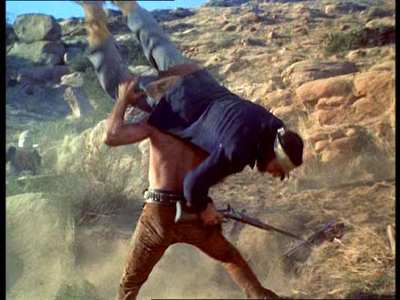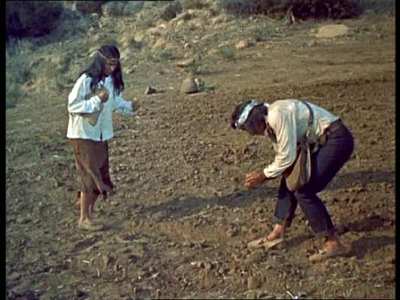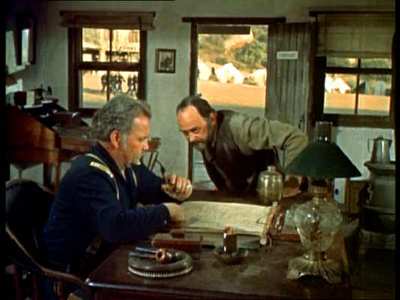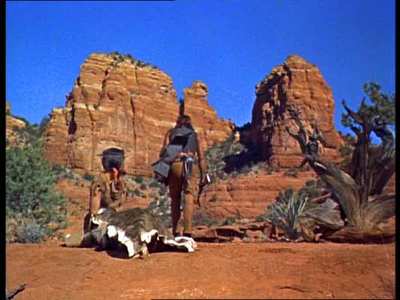Review of Apache
Introduction
The old westerns are hardly the most politically correct of affairs. Actually that was a charge that could be laid at the door of many of the old Hollywood productions, but it was most obvious in the Western. Not many children grew up playing Cowboy and Native American, and not many of the old stories could be made today. In fact, most modern westerns are often apologetic to the point of inaccuracy. It is a fact that the US government were genocidal in their treatment of the original inhabitants, also a fact that slavery was practiced until well into the 19th Century, and today the United States still has work to do overcoming the legacy of prejudice and the fight for civil rights. So looking at these early westerns, where savage Indians are mown down by the brave Cavalry, where the only role for black actors were as servants, may be exceedingly uncomfortable in the 21st Century, but they also provide a historical record of the attitudes and prejudices that existed in Hollywood as recently as the 1960s. But it would be a disservice of me to tar an entire establishment with one brush. Apache shows that even as early as 1954, Hollywood was beginning to develop a conscience. It may have been an early attempt to address the wrongs suffered by the Native Americans at the hands of the colonists, but it was also a radically different western in that it focused on the story of an Apache, rather than the intrepid cowboy shooting hordes of faceless `redskins`.
It`s 1886 and the Apache nation under Geronimo surrender to the US army. All that is, except one warrior, Massai for whom the idea of making peace is anathema. Even while Geronimo is poised to formally surrender, Massai rides to carry on the battle single-handed. Fighting alone, it isn`t long before he is apprehended, and is made to join Geronimo and the rest of the Apache warriors to be relocated away from the tribe, to distant Florida. Escaping from the train that is transporting them, Massai begins the arduous trek back to New Mexico. On the way, he encounters a Cherokee farmer who is living in peace with the white man, and making a lucrative living from corn. The Cherokee persuades him that the Apache can also live in peace, and he takes some of the corn to try. Eventually making it back to the reservation, he meets the chief, Santos and his daughter Nalinle to tell them of his idea. Nalinle, already infatuated with Massai is eager to try the farming life, but Santos betrays him. Massai realises that he is alone, that the white man and Apache alike are his enemies and after escaping, he kidnaps Nalinle and goes on a violent spree of vengeance.

Video
Apache is presented in the original 4:3 format. The picture is a tad soft, but the colours are strong and any damage has been largely cleared up. There are still rare moments of dirt and the occasional scratch though. Shot largely on location, Apache looks impressive with some glorious vistas. The famous Hollywood rock makes an early appearance, the same rock made popular in Star Trek and lampooned in Bill & Ted`s Bogus Journey. Other than that, the picture is as you would expect from a movie made in 1954.

Audio
You get DD 2.0 soundtracks in English, French, German, Italian and Spanish as is usual with many MGM back titles. There are also subtitles in several languages. The dialogue is clear and audible throughout this film, but I did notice a constant hiss that betrayed the age of the film. Fortunately this is only really obtrusive during moments of silence. The music is of the predictable `proud Indian` style.

Features
You get the theatrical trailer.

Conclusion
You have to seriously suspend disbelief to see this film as socially acceptable in 2002. In 1954 though that would have been a different matter, as the studio system would have required the name stars to be prominent. Hence we have Burt Lancaster and Jean Peters browning up to portray the Apaches of the title. Also the portrayal of the Apaches as the `noble savage` is unacceptable today, yet no one would have batted an eyelid in 1954. But Apache does make an admirable stab at seeing the plight of the conquered tribe`s viewpoint. It also doesn`t shy from showing the tribe suffering under the abuse of the white man. This must have been revolutionary when the film was first released.
Social commentary aside, the story is interesting and the characters taken in context are compelling. I say in context, as perhaps the portrayal of the Apaches as noble savages, taciturn and intrepid would today be seen as stereotypes. Burt Lancaster with his striking blue eyes seems incongruous as Massai, but both he and Jean Peters as Nalinle create interesting characters. John McIntyre as Al Sieber is also good, he is the man who is tasked with hunting Massai down, and this creates an interesting subtext with both he and Massai as the last of a dying breed. John Dehner makes for a rather one-dimensional villain in Weddle but he serves the story well. Charles Bronson here credited as Charles Buchinsky plays Hondo, the Apache working for the army who also has designs on Nalinle.
Apache is a good film let down by a rather contrived and implausible ending. You get the feeling that the ending was forced by a studio who would only want to see its leading man in the best light, but doesn`t care about remaining true to the characters. This film attempts to make social comment, and while this may have been groundbreaking in 1954, in 2002 it isn`t all that easy to swallow. However taken on its own merits as a western, this is a fairly enjoyable film.
Your Opinions and Comments
Be the first to post a comment!